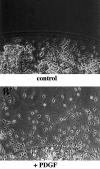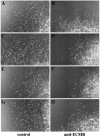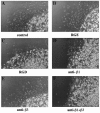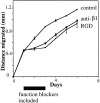A role in migration for the alpha V beta 1 integrin expressed on oligodendrocyte precursors
- PMID: 8929432
- PMCID: PMC6578950
- DOI: 10.1523/JNEUROSCI.16-22-07240.1996
A role in migration for the alpha V beta 1 integrin expressed on oligodendrocyte precursors
Abstract
Myelination of the CNS requires the migration of oligodendrocyte precursors throughout the CNS from restricted regions within the ventricular and subventricular zones. In light of the significant effects of cell-extracellular matrix (ECM) interactions on cell migration in other developing systems, we have analyzed the role of integrins in oligodendrocyte precursor migration. We have shown previously that oligodendrocyte precursors in vitro express a limited repertoire of integrins, including alpha 6 beta 1, alpha v beta 3, and that differentiation is associated with downregulation of alpha v beta 1 and upregulation of alpha v beta 5. Using a migration assay based on the movement of cells away from an agarose drop containing a high-density cell suspension, we find that RGD peptides (that block alpha v but not alpha 6 integrins) and anti-beta 1 antibodies block migration on an astrocyte-derived ECM, whereas anti-beta 3 antibodies have little effect. These results suggest that alpha v beta 1 but not alpha 6 beta 1 plays a role in oligodendrocyte precursor migration, and this is confirmed by the use of blocking monoclonal antibodies that distinguish these two integrins. In keeping with the results of others, we find that differentiated oligodendrocytes lose migratory potential and that the timing of this loss correlates with downregulation of alpha v beta 1. Taken together with the work of others showing that ECM ligands for alpha v beta 1 are expressed within the CNS, we propose that this integrin plays a significant role in the migration of oligodendrocyte precursors in vivo and that its downregulation during differentiation could be an important factor regulating the migratory phenotype of these cells.
Figures












Similar articles
-
Integrin-mediated interactions between human bone marrow stromal precursor cells and the extracellular matrix.Bone. 2001 Feb;28(2):174-81. doi: 10.1016/s8756-3282(00)00424-5. Bone. 2001. PMID: 11182375
-
Understanding the molecular basis of cell migration; implications for clinical therapy in multiple sclerosis.Clin Sci (Lond). 1997 Feb;92(2):113-22. doi: 10.1042/cs0920113. Clin Sci (Lond). 1997. PMID: 9059311 Review.
-
Division of labor of Schwann cell integrins during migration on peripheral nerve extracellular matrix ligands.Dev Biol. 1997 May 15;185(2):215-28. doi: 10.1006/dbio.1997.8547. Dev Biol. 1997. PMID: 9187084
-
Oligodendrocyte precursor migration and differentiation: combined effects of PSA residues, growth factors, and substrates.Mol Cell Neurosci. 2000 Oct;16(4):422-39. doi: 10.1006/mcne.2000.0885. Mol Cell Neurosci. 2000. PMID: 11085879
-
Integrins, cell matrix interactions and cell migration strategies: fundamental differences in leukocytes and tumor cells.Cell Adhes Commun. 1998;6(2-3):225-36. doi: 10.3109/15419069809004478. Cell Adhes Commun. 1998. PMID: 9823473 Review.
Cited by
-
Cellular signaling pathways in the nervous system activated by various mechanical and electromagnetic stimuli.Front Mol Neurosci. 2024 Oct 4;17:1427070. doi: 10.3389/fnmol.2024.1427070. eCollection 2024. Front Mol Neurosci. 2024. PMID: 39430293 Free PMC article. Review.
-
OSP/claudin-11 forms a complex with a novel member of the tetraspanin super family and beta1 integrin and regulates proliferation and migration of oligodendrocytes.J Cell Biol. 2001 Apr 16;153(2):295-305. doi: 10.1083/jcb.153.2.295. J Cell Biol. 2001. PMID: 11309411 Free PMC article.
-
Integrin alpha(v)beta1 is an adenovirus coreceptor.J Virol. 2001 Jun;75(11):5405-9. doi: 10.1128/JVI.75.11.5405-5409.2001. J Virol. 2001. PMID: 11333925 Free PMC article.
-
Laminin regulates oligodendrocyte development and myelination.Glia. 2022 Mar;70(3):414-429. doi: 10.1002/glia.24117. Epub 2021 Nov 12. Glia. 2022. PMID: 34773273 Free PMC article. Review.
-
Initiation of oligodendrocyte progenitor cell migration by a PDGF-A activated extracellular regulated kinase (ERK) signaling pathway.Neurochem Res. 2009 Jan;34(1):169-81. doi: 10.1007/s11064-008-9748-z. Epub 2008 May 30. Neurochem Res. 2009. PMID: 18512152 Free PMC article.
References
-
- Adams JC, Watt FM. Regulation of development and differentiation by the extracellular matrix. Development. 1993;117:1183–1198. - PubMed
-
- Albelda SM, Mette SA, Elder DE, Stewart R, Damjanovich L, Herlyn M, Buck C. Integrin distribution in malignant melanoma: association of the beta 3 subunit with tumour progression. Cancer Res. 1990;50:6757–6764. - PubMed
-
- Alfandari D, Whittaker CA, DeSimone DW, Darribere T. Integrin αv subunit is expressed on mesodermal cell surfaces during amphibian gastrulation. Dev Biol. 1995;170:249–261. - PubMed
-
- Almeida EAC, Huovila A-PJ, Sutherland AE, Stephens LE, Calarco PG, Shaw LM, Mercurio AM, Sonnenberg A, Primakoff P, Myles DG, White JM. Mouse egg integrin α6β1 functions as a sperm receptor. Cell. 1995;81:1095–1104. - PubMed
-
- Armstrong RC, Harvath L, Dubois-Dalcq ME. Type 1 astrocytes and oligodendrocyte-type 2 astrocyte glial progenitors migrate toward distinct molecules. J Neurosci Res. 1990;27:400–407. - PubMed
Publication types
MeSH terms
Substances
Grants and funding
LinkOut - more resources
Full Text Sources
